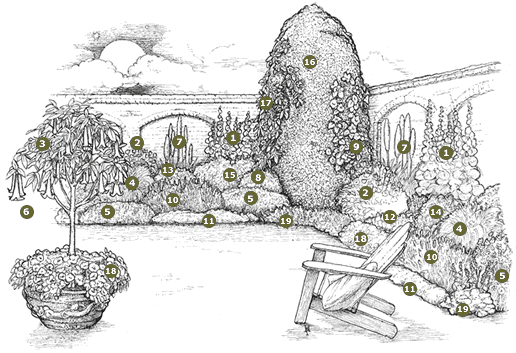A Night Garden—Growing
Plants That Come to Life After Dark
by Meghan Ray
In the first flush of springtime enthusiasm, it is easy to
imagine ourselves spending every Saturday and Sunday afternoon of the rest of
the year leisurely tending the garden. But when the weather turns hot and the
impulse to hit the beach on weekends grows strong, we venture out mainly in the
evening, when the temperature has cooled and the garden is the best place to
catch a breeze. Since evening is such a popular time to be in the garden, it is
worthwhile to ensure that the garden will be a special place at that time. As
dusk comes on, however, the blues and purples that looked so interesting during
the day become muddy. Vivid red accents on flowers, along with the greens of
most foliage, now turn to shades of gray. What can we do?
Buying fancy floodlights might help. But another solution is
to carefully select plants for flowers and foliage that stand out in the
half-light of dusk. This is the time of day when whites take on a luminous glow
and pale yellows and pinks shimmer as they never do in bright sunshine.
Patterned flowers and variegated foliage are also more visible in the evening,
contributing subtle interest and texture. Some plants, scentless by day, wait
until nightfall to release their perfumes into the air.
Selecting plants with these qualities can make a garden come
alive at night. It is not difficult to transform the night garden from something
dull and gray into a haven of exotic perfumes and ghostly flowers. Add a few
evening divas or fill the garden with them. Either way, the night garden will
invite us in.

-
Alcea rugosa (yellow
hollyhock)
-
Anemone x hybrida
'Whirlybirds' (Japanese anemone)
-
Brugmansia x candida
(angel's trumpet)
-
Carex muskingumensis 'Ice
Fountains' (palm sedge)
-
Coreopsis 'Moonbeam'
-
Cosmos bipinnatus 'Daydream'
-
Eremurus x Ruiter's hybrids
(foxtail lily)
-
Euphorbia marginata
(snow-on-the-mountain)
-
Ipomoea alba (moonflower)
-
Lavandula angustifolia 'Hidcote'
(lavender)
-
Lobularia maritima 'Pastel
Carpet' (sweet alyssum)
-
Matthiola longipetala (evening
scented stock)
-
Mirabilis jalapa 'Broken
Colors' (four-o'-clock)
-
Nicotiana x sanderae
(flowering tobacco)
-
Oenothera biennis (evening
primrose)
-
Osmanthus heterophyllus 'Gulftide'
(holly osmanthus)
-
Passiflora caerulea (passion
flower)
-
Petunia 'Tidal Wave Silver'
-
Salvia argentea (silver sage)
*Meghan Ray is the curator of the
Rock Garden at Brooklyn Botanic Garden.
![]() Gardeners' Corner
Kids'
Garden
Sustainable Garden
Contact Us
Gardeners' Corner
Kids'
Garden
Sustainable Garden
Contact Us![]()


